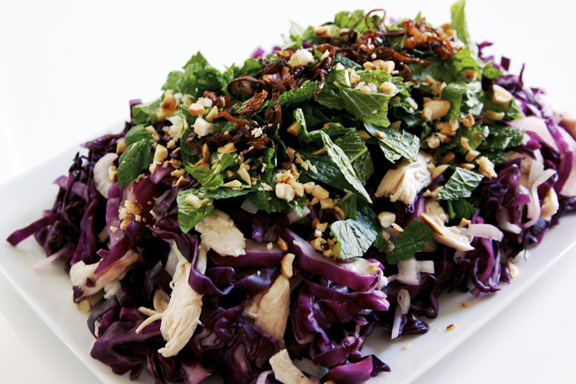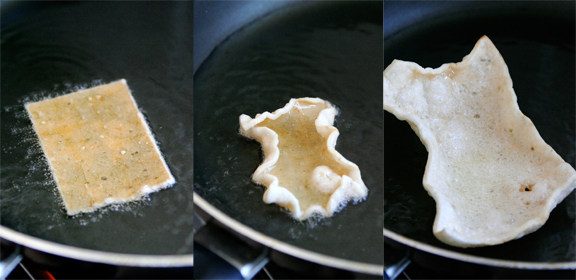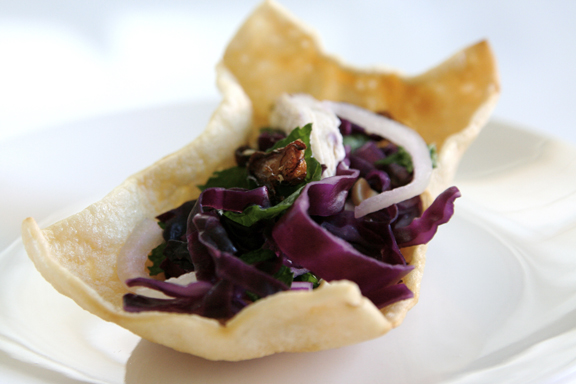
This was one of our family’s favorite dishes to make for parties, and the addition of shrimp chips made it even better. I’m not throwing a party this week, but I did put my husband on a diet. Actually, Becca did too. And leave it to her to put our husbands in competition with each other to see who can lose the most weight. We’ll see how that goes!
Luckily, Vietnamese cuisine is pretty healthy on the whole. Unlike Chinese food, where the vegetables are always cooked (don’t be surprised to find boiled lettuce in your noodle soup), Vietnamese food frequently incorporates fresh herbs and raw vegetables.
I made this salad this week for my husband to pack for lunch. I made a couple of shrimp chips too, just to show how my family usually likes to serve it, but rest assured I left that out of his lunch. :)
(A version of this recipe also ran with my fish sauce article last week.)
Vietnamese Chicken Salad (Ga Xe Phay)
Serves 3-4 as a main dish, 6-8 as a side dish
This is traditionally made with green cabbage and red onion, which is how my mom always made it. But I like to vary the colors sometimes by using purple cabbage (or a combination of green and purple) and white onion. Note that purple cabbage tends to be crisper, and green more tender. Red onion also has a little more bite than white.
2 chicken breasts, about 1 lb
1 small head of cabbage, green or purple
1 medium onion, white or red
1 bunch (8-10 stems) of Vietnamese coriander or mint, leaves roughly chopped
1 Tbsp and 2 tsp salt
2 Tbsp lime juice
2 Tbsp canola oil
2 medium shallots, thinly sliced
handful of peanuts for garnish
1 cup of nuoc cham for dressing
10-20 shrimp chips, depending on size (optional)
1 cup canola oil for frying chips (optional; vegetable or peanut oil will also work)
1. Fill a medium saucepan halfway with water (enough to just cover the chicken breasts) and bring to a boil. Once the water is boiling, place the chicken breasts into the saucepan and let the water come back up to a boil. Then cover the pot, turn off the heat, and let the chicken continue to cook for about 25-30 minutes.
2. Remove the chicken and let cool completely, then shred the meat. (The chicken broth can be reserved or frozen for another use.)
3. Remove the outer leaves of the cabbage, core, and then cut into shreds. Put the cabbage in a colander, add a tablespoon of salt, and toss to coat evenly. Let the salted cabbage sit and drain for 30 minutes or longer at room temperature. Squeeze out all excess moisture. (Optional: Taste to see if the cabbage is too salty for you. If so, you can rinse it before squeezing. Red cabbage holds up well to rinsing, but green might get a bit wilted but still tastes fine.)
4. While the cabbage is draining, finely slice the onion and sprinkle with 2 teaspoons of salt. Let this sit for 15 minutes or longer at room temperature, then rinse well 3 or 4 times to wash off all the salt. Squeeze out all excess moisture. This process helps temper the raw onion.
5. In a large bowl, combine the cabbage, onion, mint, and shredded chicken. Toss to combine.
6. Dry toast the peanuts in a small pan over medium heat, shaking the pan often. When the peanuts begin to turn golden and become fragrant, take off heat and let cool. Chop or crush the peanuts into little pieces.
7. Heat 2 tablespoons of oil in a small pan over medium to medium-low heat. Add the shallots. Once the shallots start to turn golden, remove from heat. Watch carefully to make sure they don’t burn.
8. Top the tossed salad with the fried shallots, a bit of the shallot oil, and the toasted, crushed peanuts.
9. If making shrimp chips, heat about 1 cup of oil in a deep frying pan over medium-high heat. Check to see if oil is hot enough by inserting a wooden chopstick. If small bubbles begin to form around the chopstick, the oil is ready. Add a first chip to test and turn down heat if necessary to avoid burning. The chip should expand very quickly. Once the edges start to expand, turn it over once to quickly to fry the other side. Then take it out and set on a paper-towel-lined dish to absorb excess oil. A fully expanded chip should be light and crispy. If it is too dense, it has not completely expanded. Depending on how large your shrimp chips are, continue adding one or more to the hot oil until all the chips are fried.

10. Dress the salad with nuoc cham sauce right before serving, or serve the sauce on the side. Serve the shrimp chips in a separate dish. To eat, pile a bit of salad on a chip.















Connect with us